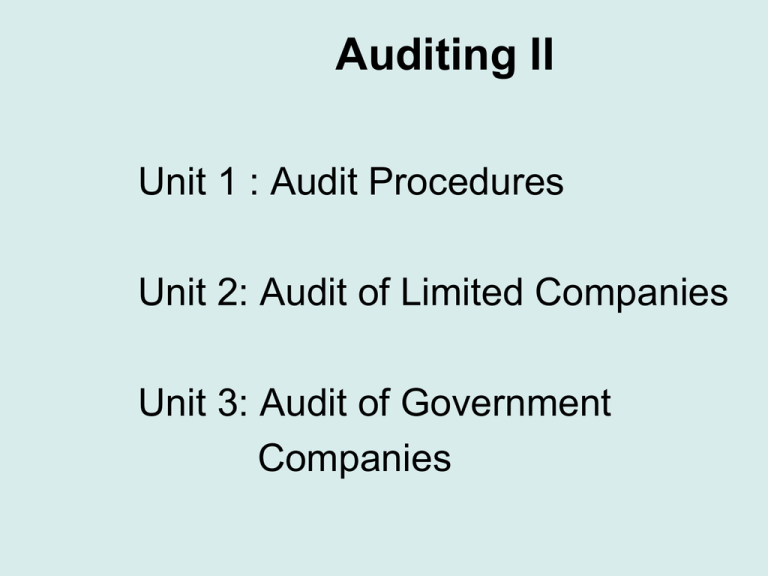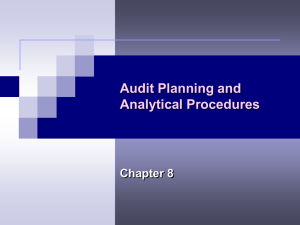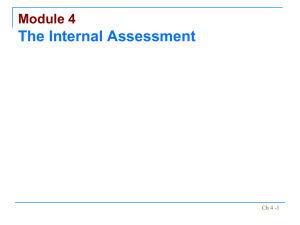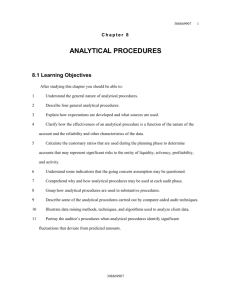Chapter 8 – Audit Planning and Analytical Procedures
advertisement

Auditing II Unit 1 : Audit Procedures Unit 2: Audit of Limited Companies Unit 3: Audit of Government Companies Unit 1: Audit Procedures Learning Objective 1 Discuss why adequate audit planning is essential. Three Main Reasons for Planning 1. To obtain sufficient competent evidence for the circumstances 2. To help keep audit costs reasonable 3. To avoid misunderstanding with the client Risk Terms Acceptable audit risk Inherent risk Planning an Audit and Designing an Audit Approach Accept client and perform initial audit planning. Understand the client’s business and industry. Assess client business risk. Perform preliminary analytical procedures. Planning an Audit and Designing an Audit Approach Set materiality and assess acceptable audit risk and inherent risk. Understand internal control and assess control risk. Gather information to assess fraud risks. Develop overall audit plan and audit program. Learning Objective 2 Make client acceptance decisions and perform initial audit planning. Initial Audit Planning Client acceptance and continuance Identify client’s reasons for audit Obtain an understanding with the client Develop overall audit strategy Learning Objective 3 Gain an understanding of the client’s business and industry. Understanding of the Client’s Business and Industry Factors that have increased the importance of understanding the client’s business and industry: Information technology Global operations Human capital Understanding of the Client’s Business and Industry Understand client’s business and industry Industry and external environment Business operations and processes Management and governance Objectives and strategies Measurement and performance Industry and External Environment Reasons for obtaining an understanding of the client’s industry and external environment: 1. Risks associated with specific industries 2. Inherent risks common to all clients in certain industries 3. Unique accounting requirements Business Operations and Processes Factors the auditor should understand: Major sources of revenue Key customers and suppliers Sources of financing Information about related parties Tour the Plant and Offices By viewing the physical facilities, the auditor can asses physical safeguards over assets and interpret accounting data related to assets. Identify Related Parties A related party is defined as an affiliated company, a principal owner of the client company, or any other party with which the client deals, where one of the parties can influence the management or policies of the other. Management and Governance Management establishes the strategies and processes followed by the client’s business. Governance includes the client’s organizational structure, as well as the activities of the board of directors and the audit committee. Corporate charter and bylaws Code of ethics Meeting minutes Code of Ethics In response to the Sarbanes-Oxley Act, the SEC now requires each public company to disclose whether is has adopted a code of ethics that applies to senior management. The SEC also requires companies to disclose amendments and waivers to the code of ethics. Client Objectives and Strategies Strategies are approaches followed by the entity to achieve organizational objectives. Auditors should understand client objectives. Financial reporting reliability Effectiveness and efficiency of operations Compliance with laws and regulations Measurement and Performance The client’s performance measurement system includes key performance indicators. Examples: market share sales per employee unit sales growth Web site visitors same-store sales sales/square foot Performance measurement includes ratio analysis and benchmarking against key competitors. Learning Objective 4 Assess client business risk. Assess Client Business Risk Client business risk is the risk that the client will fail to achieve its objectives. What is the auditor’s primary concern? Material misstatements in the financial statements due to client business risk Client’s Business, Risk, and Risk of Material Misstatement Industry and external environment Understand client’s business and industry Assess client business risk Business operations and processes Management and governance Objectives and strategies Assess risk of material misstatements Measurement and performance Sarbanes-Oxley (new title) The Sarbanes-Oxley Act requires that management certify it has designed disclosure controls and procedures to ensure that material information about business risks is made known to them. It also requires that management certify it has informed the auditor and audit committee of any significant deficiencies in internal control. Enterprise Risk Management Enterprise risk management (ERM) has emerged as a new paradigm for managing risk. ERM integrates and coordinates risk management across the entire enterprise. Learning Objective 5 Perform preliminary analytical procedures. Preliminary Analytical Procedures Comparison of client ratios to industry or competitor benchmarks provides an indication of the company’s performance. Preliminary tests can reveal unusual changes in ratios. Examples of Planning Analytical Procedures Selected Ratios Client Industry Short-term debt-paying ability: Current ratio 3.86 5.20 Liquidity activity ratio: Inventory turnover 3.36 5.20 Ability to meet long-term obligations: Debt to equity 1.73 2.51 Profitability ratio: Profit margin 0.07 0.05 Summary of the Parts of Auditing Planning A major purpose is to gain an understanding of the client’s business and industry. Key Parts of Planning Accept client and perform initial planning New client acceptance and continuance Identify client’s reasons for audit Obtain an understanding with client Staff the engagement Key Parts of Planning Understand the client’s business and industry Understand client’s industry and external environment Understand client’s operations, strategies, and performance system Key Parts of Planning Assess client business risk Evaluate management controls affecting business risk Assess risk of material misstatements Key Parts of Planning Perform preliminary analytical procedures Learning Objective 6 State the purposes of analytical procedures and the timing of each purpose. Analytical Procedures SAS 56 emphasizes the expectations developed by the auditor. 1. Required in the planning phase 2. Often done during the testing phase 3. Required during the completion phase Timing and Purposes of Analytical Procedures Purpose (Required) Planning Phase Understand client’s industry and business Primary purpose Assess going concern Secondary purpose Indicate possible misstatements (attention directing) Reduce detailed tests Primary purpose Testing Phase (Required) Completion Phase Secondary purpose Secondary Primary purpose purpose Secondary Primary purpose purpose Learning Objective 7 Select the most appropriate analytical procedure from among the five major types. Five Types of Analytical Procedures Compare client data with: 1. Industry data 2. Similar prior-period data 3. Client-determined expected results 4. Auditor-determined expected results 5. Expected results using nonfinancial data. Compare Client and Industry Data Client Inventory turnover Gross margin Industry 2007 2006 2007 2006 3.4 26.3% 3.5 26.4% 3.9 27.3% 3.4 26.2% Compare Client Data with Similar Prior Period Data 2007 Net sales Cost of goods sold Gross profit Selling expense Administrative expense Other Earnings before taxes Income taxes Net income (000) Prelim. % of Net sales $143,086 103,241 $ 39,845 14,810 17,665 1,689 $ 5,681 1,747 $ 3,934 100.0 72.1 27.9 10.3 12.4 1.2 4.0 1.2 2.8 2006 (000) % of Prelim. Net sales $131,226 94,876 $ 36,350 12,899 16,757 2,035 $ 4,659 1,465 $ 3,194 100.0 72.3 27.7 9.8 12.8 1.6 3.5 1.1 2.4 Learning Objective 8 Compute common financial ratios. Common Financial Ratios Short-term debt-paying ability Liquidity activity ratios Ability to meet long-term debt obligations Profitability ratios Short-term Debt-paying Ability Cash ratio (Cash + Marketable securities) = Current liabilities Quick ratio (Cash + Marketable securities = + Net accounts receivable) Current liabilities Current assets Current ratio = Current liabilities Liquidity Activity Ratios Accounts receivable Net sales = turnover Average gross receivables Days to collect receivable 365 days = Accounts receivable turnover Inventory turnover Cost of goods sold = Average inventory Days to sell inventory 365 days = Inventory turnover Ability to Meet Long-term Debt Obligation Debt to equity = Total liabilities Total equity Times interest = earned Operating income Interest expense Profitability Ratios Earnings per share Gross profit percent = Net income Average common shares outstanding = (Net sales – Cost of goods sold) Net sales Profit margin = Operating income Net sales Profitability Ratios Return on = assets Income before taxes Average total assets Return on common = equity (Income before taxes – Preferred dividends) Average stockholders’ equity Summary of Analytical Procedures They involve the computation of ratios and other comparisons of recorded amounts to auditor expectations. They are used in planning to understand the client’s business and industry. They are used throughout the audit to identify possible misstatements, reduce detailed tests, and to assess going-concern issues. End of Chapter 8










